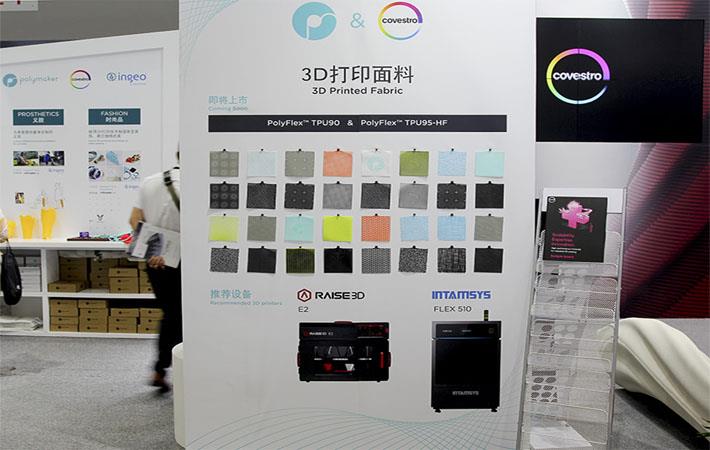Covestro and Polymaker have jointly worked out a new processing technology with the industry’s top 3D printer manufacturers Intamsys and Raise3D to improve mass production and efficiency of 3D printed fabrics. The two have jointly developed 3D printed fabric with a new approach to fabric manufacture by utilising 3D printing to create a 2D fabric.
Covestro and Polymaker have been in partnership for years to promote high-performance 3D printing materials and to develop new 3D printing applications. The Intamsys Flex 510 printer and Raise3D E2 printer are highly adapted for printing flexible materials which match the characteristics required for 3D printed fabric.Covestro and Polymaker have jointly worked out a new processing technology with the industry's top 3D printer manufacturers Intamsys and Raise3D to improve mass production and efficiency of 3D printed fabrics. The two have jointly developed 3D printed fabric with a new approach to fabric manufacture by utilising 3D printing to create a 2D fabric.#
The 3D printing technology has been widely integrated into manufacturing, sport and leisure, medical and other fields. 3D printing is now offering new applications to the textile industry which offer both mass production alongside mass customisation. 3D printing fabric may not only provide a more environmentally friendly solution, but also offers a new manufacturing method to the centuries old weaving process.
The 3D printed fabric jointly developed by Covestro and Polymaker takes a new approach to fabric manufacture by utilising 3D printing to create a 2D fabric. This has more practical value other than waste reduction and can create patterns and style with use of computer algorithms. The 2D fabrics are then integrated into the existing workflow to create a customised 3D object such as hats, shoes, bags, scarves, gloves and other clothing accessories.
Compared with traditional fabrics, 3D printing fabrics have many advantages, such as flexible production process with both mass production and customised production. Taking the production of 3D printed shoe uppers as an example, a complete upper could be printed in 30 minutes. A single 3D printer could produce 48 uppers 24 hours a day. And due to the characteristics of 3D printing technology, the design of each shoe upper produced in theory can be completely different. So, 30 devices could produce more than 10,000 fully customised uppers in a week. Customisation and mass production of 3D printed fabrics could go hand in hand for the first time.
These also offer unique textures and patterns. Relying on 3D printing technology, it is possible to make textures and patterns that are difficult to produce with traditional production methods, such as moiré, shape changes, and density gradient effects. For this unique advantage, Polymaker has developed a software for the designing and slicing of 3D printing fabric.
The design of the 3D printed fabric can be fully digitised. Using the software developed by Polymaker, design styles such as shape change, density gradient, and random lines can be achieved through algorithms. While the design freedom is greatly improved, 3D printing technology can also be able to produce these complex styles. The production process of 3D printing fabrics can all be handed over to 3D printers to achieve 24-hour automated production, without human intervention in the printing production process.
In order to meet different elasticity, strength, and hardness requirements, in addition to the performance of the material itself, the texture design and printing method of the fabric also have a critical impact. Polymaker and Covestro have explored and developed valuable methods and experience in this regard using algorithms to generate organic texture where strength is needed while allowing more breathability in areas of less stress. This allows designers to optimise their fabric and create tailored 2D patterns in the most lightweight and efficient way, in high-stress applications such as the printing of running shoe patterns this advantage becomes obvious, where lower stress fabrics can make use of the aesthetic advantages.
In the selection of materials for the development of 3D printing fabrics, Polymaker cooperated with Covestro to select from the many varieties of TPU for 3D printing development. TPU (Thermoplastic polyurethanes) is a thermoplastic polyurethane elastomer, which has a wide range of hardness, wear resistance, oil resistance, transparency, and good elasticity. It is widely used in daily necessities, sports goods, toys, decorative materials and other fields in traditional manufacture.
Covestro TPU materials are rich in variety and performance. In response to different elasticity, strength and hardness requirements, Polymaker selected the corresponding TPU raw materials, formulated the 3D printing technology modulation formula, and developed 3D printing materials. The 3D printing fabrics released this time include 90A and 95A, two hardness materials.
Facing the important global issue of environmental protection, 3D printing may better reflect its advantages. The integrated design of 3D printing could reduce the waste in the production process, and even target zero waste. In addition, in the production process of 3D printing, no water is used, no water is wasted, and water is not polluted. Compared with traditional production methods, the advantages of environmental protection could be significant.
Polymaker and Covestro have joined forces to vigorously promote the application of 3D printing in the textile industry and help the transformation and upgrading of 3D printed fabrics from artwork to industrialisation.
Fibre2Fashion News Desk (SV)
